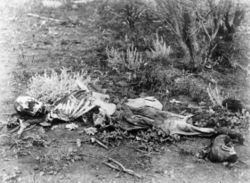| Forensic anthropology is the application of the science of physical
anthropology and human osteology (the study of the human skeleton) in a legal
setting, most often in criminal cases where the victim's remains are more or less
skeletonized. A forensic anthropologist can also assist in the identification
of deceased individuals whose remains are decomposed, burned, mutilated or otherwise
unrecognizable. The adjective "forensic" refers to the application of this subfield
of science to a court of law. Overview

Forensic anthropologists
can help identify skeletonized human remains, such as these found lying in scrub
in Western Australia, circa 1900-1910. Forensic anthropology
borrows methods developed from the academic discipline of physical anthropology
and applies them to cases of forensic importance. These techniques can be used
to assess age, sex, stature, ancestry, and analyze trauma and disease. Forensic
anthropologists frequently work in conjunction with forensic pathologists, odontologists,
and homicide investigators to identify a decedent, discover evidence of trauma,
and determine the postmortem interval. Though they typically lack the legal authority
to declare the official cause of death, their opinions may be taken into consideration
by the medical examiner. They may also testify in court as expert witness, though
data from some of the techniques commonly used in the field such as forensic facial
reconstruction are inadmissible as forensic evidence. In
the United States Physical anthropology is one of the divisions
of the American Academy of Forensic Sciences. Two of the most important
research collections of human skeletal remains in the U.S. are the Hamann-Todd
Collection, now housed in the Cleveland Museum of Natural History and the Terry
Collection, now housed in the Smithsonian Institution. These collections are an
important historic basis for the statistical analysis necessary to make estimates
and predictions from found remains. More modern collections include the William
M. Bass Donated Skeletal Collection at the University of Tennessee at Knoxville. Practitioners There
are few people who identify themselves as forensic anthropologists, and in the
United States and Canada, there are less than 100 Anthropologists certified as
Diplomates of the American Board of Forensic Anthropology. Furthermore, there
are only about 50 who are currently active in the field.[1]
Most diplomates work in the academic field and consult on casework as it arises.
References External
links |

